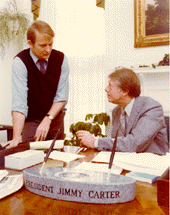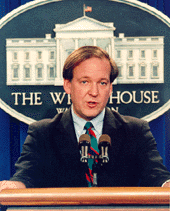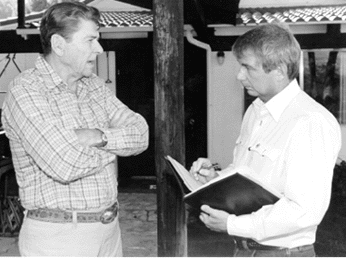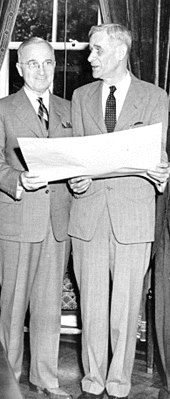
Standing In for the President
Summer 1999, Vol. 31, No. 2
By W. Dale Nelson
©1999 W. Dale Nelson
On January 26, 1903, George Bruce Cortelyou, who had been President William McKinley's secretary, wrote a memo for the guidance of the new hands in Theodore Roosevelt's White House on the duties of a presidential secretary. The memo listed among those duties the care of the White House stables. It said nothing about the White House press corps.1
How things have changed. But even in the days of McKinley, Cortelyou's assessment was not entirely accurate. John Nicolay, the former Illinois editor tapped by President Abraham Lincoln to be his secretary, was called upon, much as modern presidential press secretaries have been, to separate the wheat from the chaff for journalists seeking guidance on stories. The editor of the monthly magazine The Century consulted him about "anecdotes, reminiscences, and other hints of startling disclosures." Nicolay's daughter and biographer, Helen Nicolay, said he would usually cast doubt on the stories and discourage their publication, but once in a while he would tell the editor they were interesting and important and should be published.
Cortelyou was described by McKinley biographer Margaret Leach as "the first of the presidential press secretaries."2 This is an overstatement, as Cortelyou handled other duties. Nevertheless, he provided reporters for the first time with work space in the executive mansion, briefed them on developments in the Spanish-American War, handed out news releases, and selected news items to bring to the President's attention.3 During presidential trips, he provided the traveling press corps with advance texts of McKinley's speeches and had stenographers take down his extemporaneous remarks.4
Joseph Tumulty performed similar duties for Woodrow Wilson, describing himself at one point as the "inexhaustible font of copy" for reporters covering the White House.5 But it was not until Herbert Hoover persuaded Congress to give him three presidential secretaries instead of one that one of them was specifically assigned to deal with the press. Both George Akerson and his successor, Theodore Joslin, were former newspapermen, as neither Cortelyou nor Tumulty had been. Both were also assigned to other duties in addition to press relations, but dealing with the press was their main chore. Joslin referred to himself as "the public relations secretary."6
The evolution of what became the White House press office, from George Cortelyou to Mike McCurry, was gradual, but the change was profound. The White House press secretary does not have to worry about stables—except perhaps occasionally an Augean stable—but he does need to keep in mind constantly the needs of the press. He also needs to keep in mind that he works for the President. When Grover Cleveland was in Washington preparing to begin his second term, a journalist is said to have called on him and told him, "We have been hoping you would select a secretary who would be good to us newspaper men." Cleveland thought this over for a moment and said, "I had a notion to appoint somebody who would be good to me."7
The balance between serving the President and serving the press is a problem that faces all presidential spokesmen, whether the President be Grover Cleveland or Bill Clinton. Marlin Fitzwater, of the Reagan and Bush administrations, said the press secretary enters into combat with the press with one hand tied behind his back because he must serve two masters.8
The press does not have this handicap. Reporters work for only one master. Their objective is to get the story. But they, too, enter the fray with one hand tied behind their back. They don't have the information; they are trying to get it. The press secretary, they hope, either has it or has access to it.
The late Richard L. Strout of the Christian Science Monitor and the New Republic put the case well in an interview in 1976. "It's a game here in Washington," he said. "The executive has the sheep and we are the stealers--we're the poachers. We're trying to get the news and they are trying to keep it from us or select the news we get. And it's a game."9
Sometimes, the game is played for high stakes. On April 24, 1980, Jody Powell had a lesson in just how high they can be.
President Jimmy Carter's press secretary had known for months that the administration had a contingency plan for a mission to rescue the U.S. diplomats being held hostage in Iran. When President Carter asked him whether he thought he should attend a foreign policy breakfast at which the plan was being discussed, Powell said he believed he should. He said the secrecy of the mission would have to be protected, and that might involve misleading or lying to reporters. "If it did, I was the person to do it." Carter agreed, and Powell sat in on the meeting.
He was one of the few people in the White House who knew of the plan. When the President's chief of staff, Hamilton Jordan, was asked a question about it at a staff meeting, he denied that any rescue mission was being considered As rumors of the staff meeting circulated around Washington, Jack Nelson of the Los Angeles Times called Powell and asked him whether any rescue attempt was in the works. Powell said no decisions had been made on any military move, and it would more likely be something like a blockade if undertaken.10
On the night of the failed rescue effort, in which eight American servicemen were killed and no hostages rescued, one of the first calls Powell made was to Nelson. "I just lied to you," he said.11 Nelson, recalling the conversation later, said, "I couldn't raise any really serious concern about that, because lives were at stake."12 Powell said he considered that in such a direct conflict between two obligations, his obligation to the national interest and the lives of American citizens outweighed his obligation to be truthful.13 Although a few reporters said Powell had destroyed his credibility, most agreed that his actions were justified.
President Carter's decision to keep Powell fully informed on the rescue mission is in sharp contrast to President Kennedy's treatment of his press secretary, Pierre Salinger, during two crises involving Fidel Castro's Cuba.
A few days before the Bay of Pigs invasion, Kennedy told Salinger that he might be getting some inquiries about a military affair in the Caribbean. If he did, he was to say that he only knew what he read in the newspapers. As Salinger has said, this was saying quite a lot in April of 1961. There had been newspaper stories for some time suggesting that the U.S. training Cuban insurgents. Nevertheless, Salinger was told nothing of any of the meetings that led to the disastrous invasion. His first word came from George Herman of CBS, who called him at 6:30 in the morning and asked if he knew that Cuba had been invaded. When he got to the office, Salinger told reporters, "Our only information comes from the wire service stories we have read." After the invasion collapsed, Salinger went to the President and told him he would have to have more information if he was to do his job.14
He did not get it. When the Cuban missile crisis erupted, Kennedy told Salinger that top military and diplomatic officials would be visiting the White House during the week, but he was to deny to the press that anything special was going on. When he began getting inquiries about military preparations, he told Kennedy aide Kenneth O'Donnell, "You're going to have to cut me in pretty quick. I'm flying blind with the press." For the most part, he continued flying blind. It was not until one day before the President's televised address to the nation on the subject that Salinger was given a briefing by National Security Adviser McGeorge Bundy. Twice the President's press secretary had to do a Cuban tango without having been taught any of the steps.15
There was a reason for the difference in the ways that Powell and Salinger were treated. Salinger had a solid reputation as an investigative reporter, but he was not a Kennedy insider. The roly-poly press secretary was regarded in his early days at the White House as something of a figure of fun. Historian Arthur Schlesinger, Jr., serving as a presidential assistant, summed up the spokesman's job in one sentence: "Pierre Salinger entertained the press with jocular daily briefings."16 Powell was jocular and entertaining, too, but he was also very close to Carter. He had been with him in his campaigning for Georgia governor, in the governor's office, and in his campaign for President. Carter once said, "Jody Powell knows me better than anyone else except my wife."17
The hostage rescue mission, the Bay of Pigs, and the missile crisis are dramatic examples of a presidential press secretary's conflicting responsibilities, They were literally matters of life and death. There is another example that seems on the surface trivial, but it is not.
At the November 1985 U.S.-Soviet summit meeting in Geneva, White House spokesman Larry Speakes believed Soviet leader Mikhail Gorbachev was getting the better of President Ronald Reagan in his give-and-take with reporters. Speakes then had an aide draft some quotes, polished them up, and told reporters that they were things the President had said. One was, "The world breathes easier because we are talking together." Another was, "Our differences are serious, but so is our commitment to improving understanding." Both quotes were used extensively in the news media and attributed to the President. He did not say either one of them.
It might be argued that it doesn't matter. Who cares? The statements were hardly earth-shaking. Speakes dismissed them as "taking a bit of liberty with my P.R. man's license" in order to "spruce up the President's image."18 The trouble with this argument is that nobody had given Larry Speakes a publicity man's license. He had been given an obligation to deal honestly with the press and public.
By no means do all of the words that pour forth under the President's name originate with the President. Skilled writers craft his speeches, bureaucrats draft his veto messages, and diplomats painstakingly construct his statements during visits of foreign leaders. These, however, are adopted by the President and become his utterances. Speakes did not even consult Reagan. Reporters believed what they were told and reported that Reagan had said things he could not even have known about. If Speakes had not written about the incident in his memoirs, the quotations could have made their way from newspaper files into history books. Conceivably, they could still. The conflict was not between the press secretary's obligation to the press and his obligation to the national interest and the saving of lives. It was between his obligation to the press and, and as Speakes put it, sprucing up the President's image. Image-making won.19
Presidential press secretaries do not, of course, tell stories designed to put the President in a bad light. During the Yalta conference near the end of World War II, Acting Press Secretary Jonathan Daniels went through the pictures taken by Army Signal Corps photographers and released those that showed President Roosevelt looking relatively healthy. When he later was criticized, he conceded that to some extent he misled the American people as to the President's health but added, "I wasn't going to make him look like he was dying."20
This sounds reasonable. No censorship of the press was involved, because the pictures were not taken by news photographers but by government employees. There is, however, still a question of truthfulness. The President was dying. The conference ended on February 11, 1945, and Roosevelt died almost exactly two months later of heart disease from which he had long suffered. It is a close question whether Daniels was, in effect, lying to the press. But it should be noted that there was no faking of pictures, only a selection. Most of us, if we have a chance to select among photographs taken of us, will select the ones that make us look best. There were, of course, larger issues involved here. It might have been better had all the pictures been made public, but it seems a bit too much to expect.
It is not too much to expect that the presidential press secretary to tell the truth, if not the whole truth. Hoover's Theodore Joslin once lamented, "I sometimes wonder whether I ever will be able to tell the whole truth after serving through this position."21
It is an odd position. Larry Speakes said its occupant is "the second most visible person in the country, which can be not only an honor but a headache."22 President Johnson's George Reedy said, "The only reason for the press secretary's job is that the President cannot deal with the press 24 hours a day. You have to have somebody that acts as a stand-in for him."23 Jody Powell, after discussing his experiences in the position, said, "I have been speaking of the press secretary's job as though there were general agreement on what it is. That is not the case."24
What, then, are the qualifications for this peculiar assignment?
In 1931 Charles G. Ross of the St. Louis Post-Dispatch wrote, "My advice to all Presidents is not to put up a newspaper man to meet the press. Choose a politician. . . . Newspaper men expect a former colleague to deal with them on their own terms. When he doesn't—and often he can't—they are resentful. On the contrary, they expect only the average amount of assistance from a presidential secretary who has not had newspaper training."25
Fourteen years later, President Truman called upon Ross to be his press secretary. Charlie Ross was about to prove himself wrong.
Ross has been criticized as a press secretary on many counts. He lacked much administrative experience, and the press office he ran was by no means a tight ship. He was not always aware of everything that was going on.26 His career in journalism had been spent as an editorial page editor and a writer of long, thoughtful essays, and he seemed not to understand the highly competitive spot news reporting that is the staple of the White House beat.27 He failed to coordinate news releases with the government departments and agencies.28 He did not do much to burnish Truman's image and, as Truman biographer Alonzo Hamby has pointed out, it probably never occurred to him that this was part of his job.29 On top of all this, he was hard to hear.30
But Ross had two advantages that are important in a presidential press secretary. He was very close to President Truman. They had been high school friends in Independence, Missouri, and had renewed their friendship after Truman came to Washington as a senator. When Ross spoke to reporters—either for the record on background—they could know that he was speaking for the President. And perhaps more important, few if any reporters ever complained that Charlie Ross misled them.
As Theodore Joslin observed, a President's press secretary cannot always be expected to tell the whole truth. But he or she should be expected to tell nothing but the truth.
Notes
This essay is based on talks given by Mr. Nelson at the National Archives Building in Washington, D.C., on September 10, 1998, and at the Carter Center in Atlanta on February 23, 1997, on his book, Who Speaks for the President? The White House Press Secretary from Cleveland to Clinton (Syracuse University Press, 1998). The National Archives and Records Administration schedules author lectures throughout the year.
1. George Cortelyou, memorandum to Rudolph Forster, Jan. 26, 1903, George Bruce Cortelyou Papers, Manuscript Division, Library of Congress, Washington, DC.
2. Margaret Leach, In the Days of McKinley (1959), p. 231.
3. Ida Tarbell, "President McKinley in War Time," McClure's Magazine (July 1898): 213–214.
4. Lewis L. Gould, The Presidency of William McKinley (1980), p. 136.
5. Joseph P. Tumulty, "In the White House Looking Glass," New York Times, Dec. 31, 1921.
6. Theodore Joslin, diary, Joslin Papers, Herbert Hoover Library, West Branch, IA.
7. C. Buel, "Our Fellow Citizen of the White House: The Official Cares of a President of the United States," The Century Magazine (March 1897): 647–648.
8. Marlin Fitzwater, Call the Briefing! Bush and Reagan, Sam and Helen: A Decade with the Presidents and the Press (1996), p. 339.
9. Betty Houchin Winfield, FDR and the News Media (1990), p. 79.
10. Jody Powell, The Other Side of the Story (1964), pp. 225–232.
11. Powell, interview by the author, Feb. 29, 1996.
12. Jack Nelson, telephone interview by the author, May 28, 1946.
13. Sound Recording OH1, exit interview of Jody Powell by David Alsobrook, Dec. 2, 1980, p. 5, Jimmy Carter Library, Atlanta, GA.
14. Pierre Salinger, With Kennedy (1966), 145-47; Salinger, P.S.: A Memoir (1995), p. 109; Salinger, interview by the author; "Plucky," Time, May 1, 1961, p. 63.
15. Salinger, With Kennedy, pp. 249-255; Salinger, oral history interview, Los Angeles, Aug. 10, 1965, pp. 141–142, John F. Kennedy Library, Boston, MA.
16. Arthur M. Schlesinger, Jr., A Thousand Days: John F. Kennedy in the White House (1965), p. 207.
17. New York Times, Feb. 28, 1977.
18. Larry Speakes, with Robert Pack, Speaking Out: The Reagan Presidency from Inside the White House (1989), pp. 169–170.
19. Ibid., p. 170.
20. Jonathan Daniels, Columbia University Oral History, pp. 139-140, Franklin D. Roosevelt Library, Hyde Park, NY.
21. Theodore Joslin, diary, June 27, 1932, Joslin Papers, Hoover Library.
22. Speakes, Speaking Out, p. 1.
23. R. Gordon Hoxie, ed., The White House: Organization and Operations (1971), p. 56.
24. Powell, The Other Side, p. 303.
25. Charles G. Ross, typescript, July 10, 1931, Ross Papers, Harry S. Truman Library, Independence, MO.
26. Robert J. Donovan, Conflict and Crisis: The Presidency of Harry S. Truman, 1945–1948 (1977), p. 23.
27. James E. Pollard, "President Truman and the Press," Journalism Quarterly (Fall 1951): 467.
28. Carleton Kent, oral history interview, Dec. 21 and 29, 1970, pp. 33–34; Eben Ayers, oral history interview, Jan. 12, 1967–June 30, 1970, p. 21, both in Truman Library.
29. Alonzo L. Hamby, Man of the People: A Life of Harry S. Truman (1955), p. 301.
30. Robert S. Allen and William V. Shannon, The Truman Merry-Go-Round (1950), p. 56.



